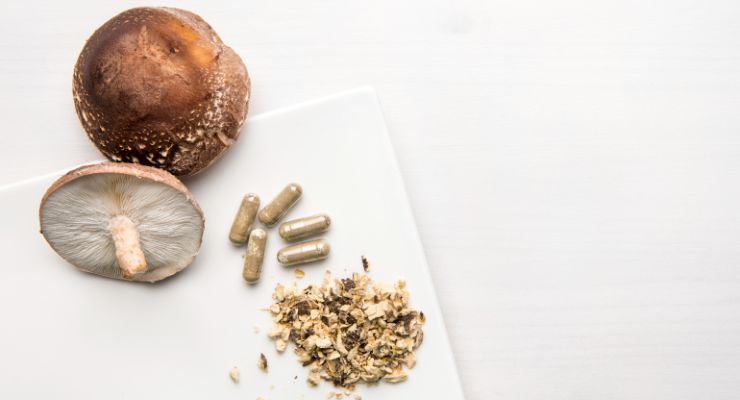11.16.23
According to a new consumer survey conducted by mushroom supplier Nammex, consumers largely recognize the word “mushroom” to mean the fruiting body of an organism, and mostly don’t recognize myceliated grain as a “mushroom.”
This consumer survey was conducted amid debate by industry stakeholders over what the word “mushroom” should represent on dietary supplement labels.
Supplements on the marketplace contain a variety of fungal parts, extracted or processed at different phases within the life cycle of a mushroom. Spores, mycelium/myceliated grain, and fruiting bodies are all parts of the same organism, but each contain different profiles of beta-glucans and other bioactive ingredients.
Survey Details
In a survey of 10,000 U.S. residents, respondents largely recognized the fruiting body of a fungus as a “mushroom,” and couldn’t define what a fruiting body was.
“We commissioned this survey as a logical extension of our campaign for clarity and accuracy in mushroom product labeling,” said Skye Chilton, Nammex CEO. “While the industry debates whether or not it’s acceptable to state or imply that mycelium-containing products are mushrooms, we thought knowing what consumers actually think was important information for the industry to actually have.”
In the survey, respondents were asked if they knew what a “fruiting body” was, but 71.5% said they didn’t know. They were then shown an image of a variety of mushrooms with caps and stems and were asked, “what are they?”
The lion’s share of consumers (90.1%) identified them as “mushrooms,” while 12.3 identified them as “fungi,” and 2.8% identified them as “fruiting body.”

The next photo showed mycelium growing on a grain substrate in a plastic bag, with the question “is this a mushroom?”; 20.7% identified the myceliated grain as a mushroom, and 79.3% checked the “not a mushroom” box.
Those who identified the myceliated grain as “mushrooms” said they did so because of the context of the survey, or the fact that they’d used mushroom growing kits.

“This data confirms that the vast majority of consumers have a fairly specific idea of what constitutes a mushroom, and it’s not myceliated grain,” Chilton said. “As we have said all along, to the industry and to FDA with our Citizen Petition asking for labeling clarity, it’s essential to be fair to consumers and not imply they are getting something they are not when they buy a product. It’s not only ethical, it protects the industry from losing their trust.”
Supplement Semantics
Nammex requested in its Citizen Petition to FDA that the agency enact requirements for mushrooms similar to botanical ingredinets in which the parts of a given organism would need to be reported. Botanical manufacturers are required to list whether a given product is derived from aerial parts or the root of a plant, and the company requested similar transparency requirements for mushrooms versus mycelium or any other fungal parts.
Mushroom companies Fungi Perfecti, M2 Ingredients, Gourmet Mushrooms, and Monterey Mushrooms jointly wrote an open letter in response to Nammex’s petition, where they argued that mushroom has been a longstanding term to describe the entire organism, and efforts to change that are a source of public confusion.
This consumer survey was conducted amid debate by industry stakeholders over what the word “mushroom” should represent on dietary supplement labels.
Supplements on the marketplace contain a variety of fungal parts, extracted or processed at different phases within the life cycle of a mushroom. Spores, mycelium/myceliated grain, and fruiting bodies are all parts of the same organism, but each contain different profiles of beta-glucans and other bioactive ingredients.
Survey Details
In a survey of 10,000 U.S. residents, respondents largely recognized the fruiting body of a fungus as a “mushroom,” and couldn’t define what a fruiting body was.
“We commissioned this survey as a logical extension of our campaign for clarity and accuracy in mushroom product labeling,” said Skye Chilton, Nammex CEO. “While the industry debates whether or not it’s acceptable to state or imply that mycelium-containing products are mushrooms, we thought knowing what consumers actually think was important information for the industry to actually have.”
In the survey, respondents were asked if they knew what a “fruiting body” was, but 71.5% said they didn’t know. They were then shown an image of a variety of mushrooms with caps and stems and were asked, “what are they?”
The lion’s share of consumers (90.1%) identified them as “mushrooms,” while 12.3 identified them as “fungi,” and 2.8% identified them as “fruiting body.”

The next photo showed mycelium growing on a grain substrate in a plastic bag, with the question “is this a mushroom?”; 20.7% identified the myceliated grain as a mushroom, and 79.3% checked the “not a mushroom” box.
Those who identified the myceliated grain as “mushrooms” said they did so because of the context of the survey, or the fact that they’d used mushroom growing kits.

“This data confirms that the vast majority of consumers have a fairly specific idea of what constitutes a mushroom, and it’s not myceliated grain,” Chilton said. “As we have said all along, to the industry and to FDA with our Citizen Petition asking for labeling clarity, it’s essential to be fair to consumers and not imply they are getting something they are not when they buy a product. It’s not only ethical, it protects the industry from losing their trust.”
Supplement Semantics
Nammex requested in its Citizen Petition to FDA that the agency enact requirements for mushrooms similar to botanical ingredinets in which the parts of a given organism would need to be reported. Botanical manufacturers are required to list whether a given product is derived from aerial parts or the root of a plant, and the company requested similar transparency requirements for mushrooms versus mycelium or any other fungal parts.
Mushroom companies Fungi Perfecti, M2 Ingredients, Gourmet Mushrooms, and Monterey Mushrooms jointly wrote an open letter in response to Nammex’s petition, where they argued that mushroom has been a longstanding term to describe the entire organism, and efforts to change that are a source of public confusion.




























